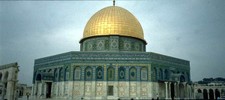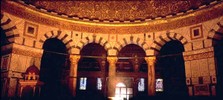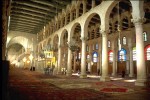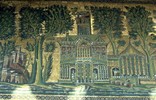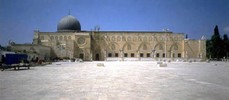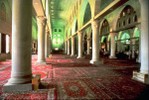Previous Lecture | Next Lecture
Concepts
The Umayyads: First Islamic dynasty (661-750) established by a companion of the Prophet, Mu'awiya. Their capital was Damascus. They built the first monumental mosques.
Abd al-Malik: Fifth Umayyad caliph (685-705), organized the Caliphate, Arabicized the administration and Islamized the coinage after he had subdued several revolts against the rule of his family.
The Night Journey and the Ascension (Al-Isra' wa-l-Miraj): The miraculous journey of the Prophet from Mecca to Jerusalem and his ascension to Heaven to receive from God major doctrinal requirements.
New Elements in Mosque Architecture
Concave mihrab: reportedly first introduced in the Mosque of the Prophet at Medina in 707.
- Minaret: earliest examples may have been the towers flanking the northern side of the original Roman temenos where the Great Umayyad Mosque of Damascus was built.
- Maqsura: a private area in the prayer hall enclosed by a wood screen for the ruler and his entourage.
- Dome in the central nave in front of the mihrab: first appeared in Damascus and may have been adopted from palatial Roman and Byzantine precedents as illustrated in mosaic by the representation of the "Palace of Thoederic" in St. Appolinaire Nuevo in Ravenna (ca. 490).
- Khazna: treasury, a structure possibly used as a vault in the mosque's courtyrad.
Decoration of Mosques:
- The use of inscriptions in the Kufic style.
- The use of glass mosaic.
- The absence of figural representation.
- Vegetal and geometric motifs, derived mostly from Classical traditions.
Monuments
Dome of the Rock (Qubbat al-Sakhra): The first consciously-monumental Islamic structure is a martyrium built in Jerusalem (692) by 'Abd al-Malik to commemorate the sanctity of the site and the city in general.
Umayyad Mosque of Damascus (ca. 706-15): First imperial mosque built by Caliph al-Walid I (705-15), the son of Abd al-Malik.
The Farthest Mosque (al-Masjid al-Aqsa) in Jerusalem


